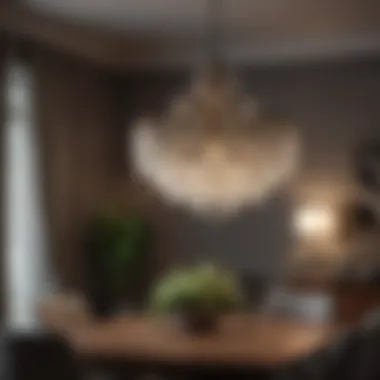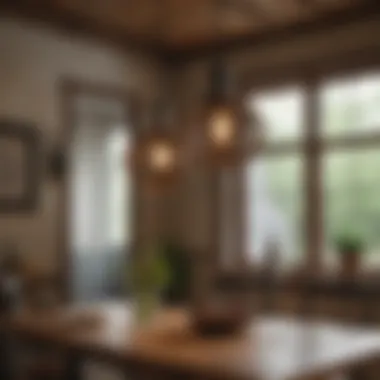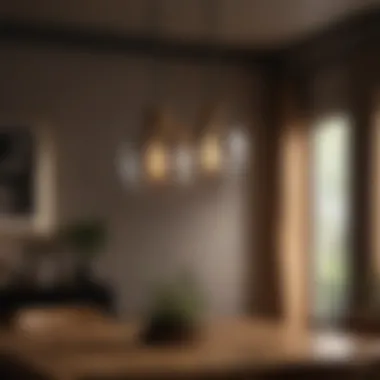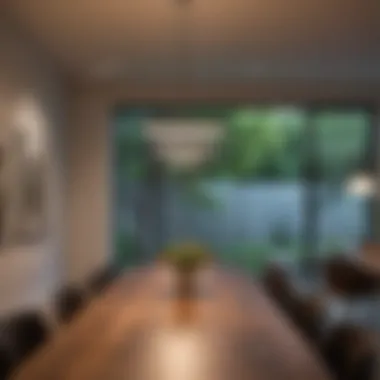Ultimate Dining Room Hanging Lighting Fixtures Guide


Intro
In the realm of interior design, dining room lighting plays a crucial role. The right fixtures not only illuminate the space but also enhance the overall aesthetic. Homeowners looking to revamp their dining areas may find themselves overwhelmed by choices. Hanging lighting fixtures, in particular, offer unique opportunities for both functionality and design. This guide will delve into various types of hanging fixtures, their benefits, and what factors to consider when selecting and installing them.
Understanding the nuances of dining room lighting can significantly improve the dining experience. From intimate family dinners to large gatherings, how the space is lit impacts everything. This article aims to offer insights that will inspire homeowners and design enthusiasts alike.
Prolusion to Dining Room Lighting
Lighting in dining rooms plays a crucial role in shaping the overall atmosphere of the space. Beyond mere functionality, it enhances the dining experience and sets the tone for gatherings. Properly designed lighting fixtures can create a welcoming environment that encourages conversation and relaxation.
When considering dining room lighting, it is essential to think about how different fixtures interact within the space. Good lighting not only illuminates but also emphasizes the style and decor of the room. For example, a well-chosen chandelier can serve as a statement piece, drawing attention and framing the dining area beautifully.
The Role of Lighting in Dining Spaces
The primary purpose of lighting in dining spaces transcends simple visibility. Adequate illumination contributes to the aesthetic appeal and emotional comfort of the room. Bright lighting can energize a gathering, making it feel lively and dynamic, while softer lighting can create a tranquil, intimate environment suitable for family dinners or romantic dates.
Moreover, various types of lighting can be utilized to highlight specific areas. Task lighting focuses on the dining table while ambient lighting can diffuse warmth throughout the room. Such variances enrich the dining experience, allowing flexibility depending on the occasion.
Importance of Fixture Selection
Fixture selection is crucial in achieving the desired ambiance and functionality in dining rooms. A suitable lighting design should cater to both practical needs and stylistic preferences.
Different fixture types and styles can drastically alter the impression of the space.
- Chandeliers, for instance, often symbolize elegance. They offer grandeur, becoming the focal point.
- Pendant lights add a modern touch, suitable for casual settings.
- Flush mounts present a streamlined appearance for low ceilings.
Careful consideration of size, style, and placement ensures that the fixtures contribute positively to the overall aesthetics and usability of the dining area. Selecting the right fixtures can enhance not only visual appeal but also the functionality of the dining space.
Types of Hanging Lighting Fixtures
In the realm of dining room design, the choice of hanging lighting fixtures holds significant importance. They serve as not just sources of illumination, but also as defining elements of the room’s overall aesthetic. The variety in design, style, and functionality allows homeowners to express their taste and enhance the dining experience. Choosing the right fixture can contribute to creating atmosphere conducive for meals, gatherings, or casual family dinners.
Hanging lighting fixtures come in different forms, each with its set of characteristics. Knowledge of these types and their specific benefits can help in making informed design decisions. Not only do they vary aesthetically, but they can also influence how light distributes in a space, affecting both mood and visibility.
Chandeliers
Chandeliers are emblematic of elegance in lighting. Often regarded as the centerpiece of dining rooms, chandeliers can significantly augment the room's visual appeal. They provide ambient light and can accommodate various bulb types to alter intensity. Their designs range from classical opulence to modern minimalism, each contributing uniquely to the dining atmosphere. A well-selected chandelier can draw the eye upward, making ceilings appear taller and adding a sense of grandeur.
Pendant Lights
Pendant lights are a versatile option, coming in various shapes and sizes. Their adaptability makes them suitable for different dining room styles, from contemporary to rustic.
Single Pendant


The single pendant light stands out for its simplicity and effectiveness. It offers focused lighting on a specific area, making it a practical choice for small dining tables. The ability to choose various styles and finishes allows homeowners to align the light with the surrounding decor. However, its limited lighting coverage may not suit larger dining areas, necessitating additional fixtures for comprehensive illumination.
Cluster Pendant
Cluster pendants offer a visually striking arrangement of lights. This flexibility allows for creative displays above dining tables, bringing a unique flair to the space. Clusters can draw attention and become conversation starters. The main drawback might be the complexity in arrangement, requiring careful planning to ensure even light distribution.
Multi-Light Pendants
Multi-light pendants bring the advantage of versatile illumination and are suitable for larger dining settings. They provide a wider spread of light, enhancing visibility across the table. The design possibilities are numerous, allowing for complementing various interiors. However, their size and visual weight might overwhelm a room with low ceilings.
Flush Mounts with Hanging Features
Flush mounts with hanging features merge the design of flush-mounted lights with hanging elements. This hybrid style offers an elegant touch while remaining practical for spaces with low ceilings. They provide decent illumination without dominating the overhead space. Their discreet design may not provide the same visual impact as a chandelier but contributes to a balanced aesthetic.
Track Lighting
Track lighting introduces a modern element to dining spaces. Its best feature is flexibility in direction and focal points. Homeowners can adjust the lights to highlight specific areas, artwork, or decor, maximizing the fixture’s effectiveness. It offers the practicality of customizing light intensity based on need or occasion. However, the look may not suit more traditional dining areas, which often favor more decorative fixtures.
Sconces as Accent Lighting
Sconces work as accent lighting, providing subtle illumination that enhances the dining experience. They can be used to light hallways leading to the dining area or highlight the walls in the room. The strategic placement of sconces adds depth and character. Their limitations lie in providing full room illumination, as they are not designed as primary light sources.
Choosing the right hanging fixture can transform a dining room into a stylish gathering space.
Design Considerations for Hanging Fixtures
Designing the perfect lighting scheme in a dining room requires careful consideration of various factors, particularly when it comes to hanging fixtures. These elements not only serve practical purposes—like illuminating the dining area—but also contribute significantly to the room’s overall aesthetic. When selecting hanging fixtures, one must think about their height and placement, style and aesthetics, as well as material choices. Each of these aspects plays a crucial role in creating an environment that is inviting and functional.
Height and Placement Guidelines
Getting the height and placement right is essential for maximizing both function and form. A common guideline is to hang the fixture approximately 30 to 36 inches above the tabletop. This allows for ample light without obstructing sightlines during meals. Additionally, if the dining room has high ceilings, a larger fixture can create a dramatic focal point. Consideration should also be given to how many fixtures are used; multiple pendants might need to be spaced differently than a single chandelier to ensure an even distribution of light.
Style and Aesthetics
The design style of hanging fixtures can significantly influence the dining room’s ambiance. Different styles, such as Modern, Traditional, Industrial, and Rustic, cater to various tastes and preferences.
Modern
Modern hanging fixtures often feature clean lines and minimalistic designs. Their simplicity allows them to blend well with various interior styles, making them a popular choice. Key characteristics include geometric shapes and a focus on materials like metal and glass. This minimalistic approach can add a sense of sophistication without overwhelming the space. However, some might find modern fixtures too stark or cold, depending on other decor elements in the room.
Traditional
Traditional fixtures tend to incorporate ornate designs and classic materials. They often include intricate detailing, which adds richness to dining spaces. The key characteristic of traditional style is its elegance and warmth, making it well-suited for settings aiming for a timeless feel. Their unique features often contribute to a home's character, but they can sometimes clash with more contemporary decor.


Industrial
Industrial fixtures evoke a raw, unfinished aesthetic. This style is characterized by exposed bulbs and utilitarian materials like wrought iron or reclaimed wood. They serve as a striking contrast in more polished decor schemes. Their rugged charm adds a touch of character, but they may not fit well in very formal dining settings. Additionally, the bulb exposure can sometimes result in harsher lighting, which may not always suit an inviting atmosphere.
Rustic
Rustic fixtures emphasize natural materials like wood and stone. They create a cozy, welcoming atmosphere in any dining room. The key characteristic of rustic lighting is its ability to impart warmth through texture and earth tones. Unique features often include handcrafted elements and a homely feel, making them great choices for country or farmhouse designs. However, rustic styles might not blend seamlessly into modern or sleek interiors.
Material Choices
The materials used in hanging fixtures can greatly affect both their functionality and aesthetic appeal.
Metal
Metal fixtures are durable and versatile, offering a modern yet sturdy option. They can be crafted in a variety of finishes, such as brushed nickel or wrought iron. The key characteristic of metal is its long-lasting nature, making it a common choice for dining rooms. Unique features often include a variety of shapes and styles, yet some may find metal to be overly cold or impersonal, depending on the finish chosen.
Glass
Glass fixtures bring elegance and lightness to dining spaces. They are particularly effective in diffusing light, creating a warm ambiance. The key characteristic of glass is its ability to blend various styles, offering either clarity in modern designs or ornate patterns in more traditional setups. However, glass is also more fragile, requiring careful handling and maintenance.
Fabric
Fabric fixtures add softness and texture to the room. They can introduce colors and patterns, enhancing the overall design theme. The key characteristic of fabric is its ability to create a cozy, inviting atmosphere. Unique features might include adjustable lampshades that can change ambiance depending on the mood or occasion. However, some find that fabric fixtures may require more cleaning and care than other materials.
Wood
Wood fixtures offer a warm and organic feel. They can range from polished to rustic finishes, thus catering to various styles. The key characteristic of wood is its natural beauty and range of colors. Unique features often encompass unique grain patterns and textures, enhancing any dining room's design. However, wood can be sensitive to moisture and temperature changes, necessitating proper maintenance to preserve its aesthetics.
Considering both the style and material of hanging fixtures can transform a dining area, making it more than just a space for meals but a true extension of the home’s character.
Functional Aspects of Dining Room Lighting
Dining room lighting extends beyond mere illumination; it shapes the atmosphere and enhances the functional use of the space. Selecting the right fixtures involves an understanding of how light interacts within the dining area. This section delves into the fundamental roles of lighting, emphasizing flexibility, comfort, and energy efficiency.
Layering Light for Versatility
Layering light involves combining different lighting types. This approach includes ambient, task, and accent lighting to create a balanced environment. Ambient lighting provides the overall illumination of the room, task lighting is dedicated to specific activities like dining, and accent lighting highlights decor. By integrating various lighting sources, homeowners can establish a versatile space that adjusts to different occasions, from casual family dinners to formal gatherings.
Utilizing Dimmers
Dimmers have become a popular feature in dining room lighting. They allow for brightness adjustment, providing flexibility no matter the situation. A dimmer switch can transform the mood of the dining area instantly. For instance, brighter lights may be used during meal prep, while softer tones create a cozy atmosphere for evening meals. Moreover, utilizing dimmers can extend the lifespan of bulbs, which enhances energy efficiency, contributing to lower electricity bills.
Energy Efficiency Considerations


Energy efficiency is a pivotal aspect when it comes to dining room lighting. Homeowners are increasingly seeking solutions to reduce energy consumption without compromising on light quality. Integrated technologies like LED options and smart lighting solutions play a crucial role in this endeavor.
LED Options
LED lighting has gained favor due to its low energy consumption and longevity. The remarkable lifespan of LED bulbs, often exceeding 25,000 hours, makes them cost-effective in the long run. Additionally, LEDs generate less heat compared to traditional light sources, contributing to a cooler dining environment. For those focused on sustainability, the energy efficiency of LEDs aligns with environmental considerations, making them a favored choice.
Smart Lighting Solutions
Smart lighting solutions represent a modern approach to managing illumination in the dining room. With the use of apps and voice-enabled devices, homeowners can control their lighting settings from anywhere within their home. The ability to set schedules, adjust brightness, and even change colors offers unparalleled flexibility. This technology caters to energy savings; smart lights can automatically turn off when not in use, reducing waste. Consequently, smart lighting contributes not only to convenience but also aligns with sustainable practices.
Understanding the functional aspects of dining room lighting allows for an informed and thoughtful approach to fixture selection. It is vital to consider how these elements serve the space and its users.
Installation and Maintenance Tips
Understanding the intricacies of installation and maintenance is crucial when dealing with hanging lighting fixtures in your dining room. Ensuring proper installation can enhance safety and optimize the lighting effects that contribute to the overall ambiance of the space. Furthermore, regular maintenance routines not only prolong the life of the fixtures but also maintain their aesthetic and functional performance over the years.
Safety Precautions During Installation
When installing hanging fixtures, safety must be the top priority. Here are several key considerations:
- Turn Off Power: Before beginning, ensure that the electricity supply to the area is turned off. This helps prevent accidents and electrical hazards.
- Use Quality Tools: Employ the right tools designed for light installation. A proper screwdriver, wire cutter, and voltage tester can make the process smoother and safer.
- Follow Instructions: Each fixture comes with specific installation guidelines. It's essential to closely follow these instructions to avoid misalignment or improper functioning.
- Secure the Fixture Properly: Ensure that the fixture is firmly anchored to avoid any risk of it falling. Use appropriate anchors, especially in drywall or ceiling materials that necessitate additional support.
- Seek Professional Help if Needed: If unsure about the installation process, it is wise to consult or hire a professional electrician. They can ensure that all local codes and regulations are met.
Regular Maintenance Routines
Maintaining your hanging light fixtures is critical for both functionality and cleanliness. Regular upkeep will not only enhance the light's brightness but also preserve its beauty. Key aspects of a maintenance routine include:
- Clean Regularly: Dust and grime can accumulate on fixtures, dulling their appearance and efficiency. Wipe down surfaces with a soft, damp cloth monthly to keep them looking new.
- Check Bulbs: Regularly inspect and replace burned-out bulbs to ensure consistent lighting levels. This also helps in preventing electrical issues stemming from faulty bulbs.
- Inspect Wiring and Connections: Look for any visible wear or damage, including frayed wires or loose connections. If you notice anything concerning, have it addressed immediately to avoid potential hazards.
- Evaluate Fixture Alignment: Occasionally check that your hanging fixtures are level and securely attached. Over time, they may shift, especially if they are adjustable.
- Schedule Professional Inspections: At least once a year, consider having your fixtures examined by a professional. This can catch any underlying issues early, ensuring a safe and pleasant dining environment.
*Proper installation and maintenance practices can significantly enhance both the safety and aesthetic value of dining room lighting fixtures.*
The End
The conclusion of this article serves as a crucial wrap-up of the essential elements discussed throughout the guide on dining room lighting fixtures. Understanding the significance of hanging lighting is vital not only for enhancing aesthetics but also for creating a comfortable and inviting atmosphere for dining experiences. The various types of fixtures such as chandeliers and pendant lights provide unique stylistic options that can elevate the interior design of any dining space. Moreover, recognition of the functional aspects, like the importance of layering light or suitable material choices, directly correlates to how well a dining area performs for its intended purpose.
Summarizing Key Points
In this guide, we explored different types of hanging fixtures: chandeliers, pendant lights, flush mounts, and track lighting. Each type has its own distinct characteristics and roles in dining spaces.
- Chandeliers offer grandeur and are often central features.
- Pendant lights can provide focused lighting, ideal over dining tables.
- Flush mounts with hanging features offer low profiles in tighter spaces.
- Track lighting allows for flexibility in design and can enhance vignette areas.
- Sconces add an accent, contributing to illumination and style without overwhelming the space.
Throughout, we analyzed design considerations, emphasizing height and placement guidelines to ensure optimal light flow, while maintaining aesthetic appeal in various styles from modern to rustic.
Future Trends in Dining Room Lighting
Looking forward, several trends in dining room lighting are emerging. Firstly, the incorporation of smart technology is revolutionizing control over fixtures. Homeowners increasingly prefer adjustable lighting solutions that can create various moods and atmospheres with a click.
Secondly, sustainability plays a growing role in lighting choices. Energy-efficient bulbs, especially LED options, are gaining traction as more homeowners prioritize energy savings alongside beautiful designs.
Finally, customized installations and unique, artistic fixtures rise in popularity. Consumers wish for lighting that not only illuminates but also complements their individual style. Connecting functionality and design will drive future innovations in dining room lighting.
Ultimately, mastering dining room lighting fixtures not only improves your space but also reflects personal taste and fosters inviting environments.







